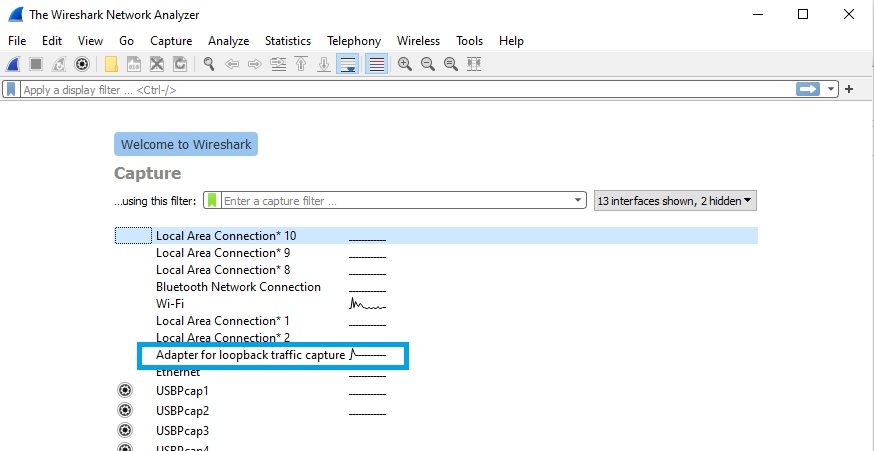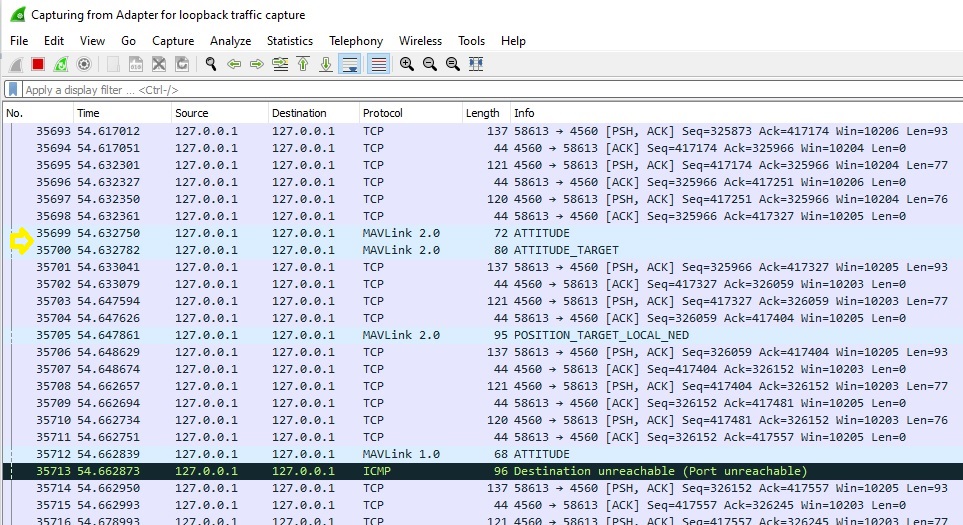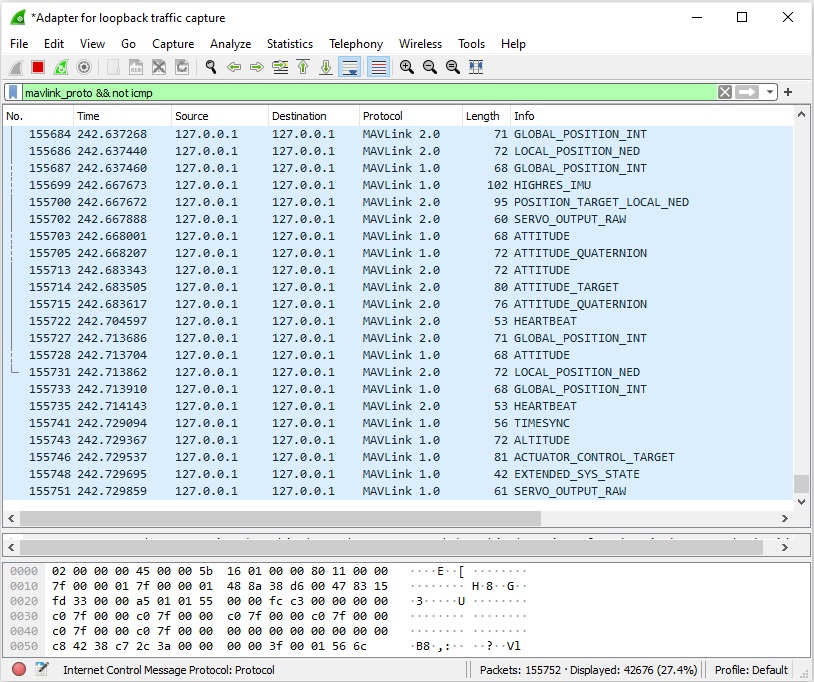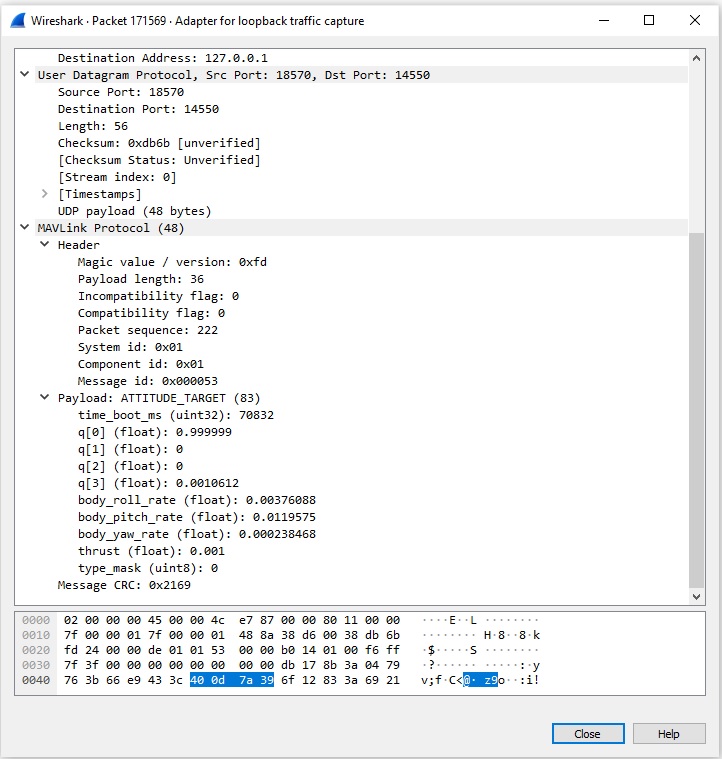Parsing MAVLink in Wireshark
Wireshark is an extremely popular "general purpose" network protocol analyzer that can be used to inspect and analyse MAVLink traffic.
The benefits of using Wireshark over other alternatives are:
- it can view all traffic on a network interface (GCS tools like MAVLink Inspector often only analyse incoming traffic).
- you can use it to analyse traffic logged on a companion computer (this allows analysis of traffic between the companion computer and flight controller, which might otherwise not be visible to Wireshark).
- it is easy to update for new custom messages and dialects. Rebuilding QGroundControl so you can use it analyse custom messages is much harder!
This topic shows how to generate a Wireshark plugin for a particular dialect file and install it on Wireshark, and how to perform basic filtering. It also provides an overview of how you can use tcpdump for collecting traffic on a linux computer (for later analysis).
INFO
You will need to regenerate and reimport the plugin (as shown below) if your dialect changes.
Generate MAVLink Lua Plugin for Wireshark
First you will need to generate a Wireshark plugin that includes definitions for the MAVLink messages that you want it to handle. The MAVLink generator (mavgen) can build this plugin for a dialect in the same way as it builds MAVLink libraries for other programming languages.
The steps are:
Install MAVLink (if you have not already done so).
Build libraries for your target dialect, specifing
WLuaas the target language. This process is described in the topic Generate MAVLink Libraries.For example, to build the MAVLink 2 Wireshark plugin for common.xml you might use the following command:
bashpython3 -m pymavlink.tools.mavgen --lang=WLua --wire-protocol=2.0 --output=mavlink_2_common message_definitions/v1.0/common.xmlThe plugin would be created in the current directory as: mavlink_2_common.lua.
Update Plugin with Correct Ports
The last few lines of the plugin file specify the ports to be monitored.
-- bind protocol dissector to port 14550 and 14580
local udp_dissector_table = DissectorTable.get("udp.port")
udp_dissector_table:add(14550, mavlink_proto)
udp_dissector_table:add(14580, mavlink_proto)
udp_dissector_table:add(18570, mavlink_proto)These first two ports are the correct ports to monitor network traffic between a simulated autopilot and a GCS and offboard API. The final port (18570) can be used to monitor a simulation running in WSL2.
If you want to monitor other interfaces then you can modify or add to these lines and then save the plugin file. This might be necessary, for example, in order to monitor traffic recorded on the interface between a companion computer and a flight controller.
Import Lua Plugin into WireShark
To import the plugin into Wireshark:
Copy the plugin file into the wireshare plugins directory.
- On Linux systems this might be:
~/.local/lib/wireshark/plugins(or~/.wireshark/pluginsfor older versions of Wireshark). Note that users will need to be added to thewiresharkgroup to use the tool.) - On Windows this might be:
Program Files/Wireshark/plugins.
- On Linux systems this might be:
Open Wireshark and follow the menu: Help > About Wireshark > Plugins
You should find the plugin in the list. For example, with the plugin created in the previous section you would see
mavlink_2_common.lua
View Traffic on Wireshark
Wireshark can inspect any interface on the host computer on which it is running. So you can use it to inspect traffic between a GCS and running on the same computer and a real or simulated computer.
For example assuming you have a simulator and ground station running on the same computer, select the Adapter for loopback traffic capture.

This will display all traffic on the interface. With the MAVLink WLua plugin installed, MAVLink message names are displayed next to each UDP packet that contains a MAVLink message.

You can filter to show just the MAVLink traffic using mavlink_proto in the filter box (below we also filter on not icmp to remove additional control packets).

Click on a particular message to find out its details. Below you can see the payload and the header details for an ATTITUDE_TARGET message:

Filtering using MAVLink Properties
In addition to using filters for the usual Wireshark things (e.g. ips and ports) you can also use the new MAVLink filters.
INFO
This works the same way for live view and for a pcapng file loaded into Wireshark
We already saw you can filter for MAVLink packets using mavlink_proto. The following is a filter example:
mavlink_proto.msgid==0 && mavlink_proto.compid == 1 &&
(ip.addr == 10.0.115.155 && ip.dst == 10.0.115.141)This means to filter for:
- Mavlink msgid=
HEARTBEAT - Mavlink src compid=
AUTOPILOT - src IP=
10.0.115.155 - dst IP=
10.0.115.141
Capture MAVLink Stream
On Linux you can use tcpdump to capture stream on a specific interface. This can be performed either on your laptop or on the offboard computer:
apt update
apt install tcpdump
tcpdump -i eth0 -w mavlink-capture.pcapCapture tcpdump (MAVLink) data live from a remote machine on a local WireShark
tcpdump must be installed on the remote machine.
When you can access the remote machine with SSH you can stream the tcpdump to your local machine instead of logging it to a file. Wireshark can open this stream and show the decoded MAVLink messages using the tools and filters from above.
mkfifo /tmp/mavlink;
wireshark -k -i /tmp/mavlink &
ssh root@10.41.1.1 -p 33333 "tcpdump -s 0 -U -n -w - -i lo not port 33333" > /tmp/mavlink;INFO
Username, IP and port above have to be adjusted to the configuration on the remote machine.
mkfifo /tmp/mavlinkCreates a named pipe that is used to stream the data.wireshark -k -i /tmp/mavlink &Start Wireshark, open the named pipe as input and start the capture immediately.Start the data stream on the remote machine and pipe it into the named pipe on your local machine.
-s 0Set snapshot length to default-UStream packet output packet-buffered, don’t wait for a full buffer-nDon't convert addresses (i.e., host addresses, port numbers, etc.) to names-w -Write raw data to standard output (piped to the local machine)-i loDefine which interface to listen on. This will listen to the loopback interface, you can change this to the Ethernet, USB or modem interface.not port 33333Don’t capture the data created by the SSH session. You can add more filters to tcpdump to reduce the streamed data.
Measuring MAVLink data rates using Wireshark
After the plugin is setup in Wireshark and you have started to capture a stream you can use the Wireshark IO graphs to monitor message rates for either the whole stream or just specific messages.
To do this you need to go to Statistics > I/O Graphs and you will get a new window. Now you will a plot of the data rate of all packets you are analyzing. You can filter for the usual Wireshark filters and the new MAVLink ones introduced by the LUA script.
We recommend changing the y axis to bits or bytes and to reduce the x axis to 10ms or faster to get meaningful plots.

